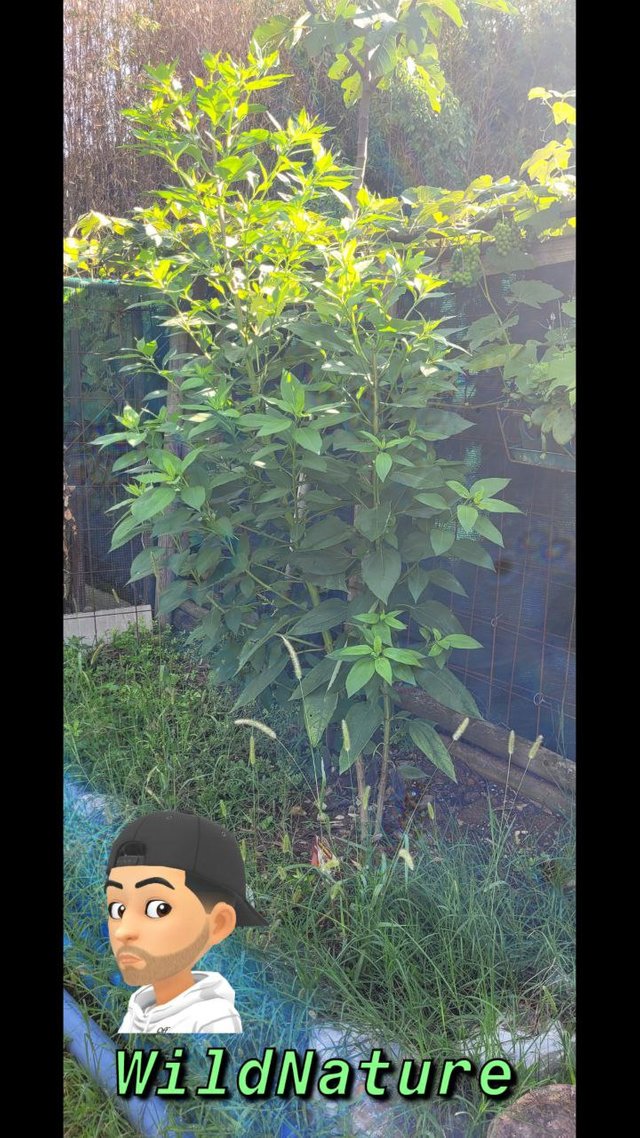Topinambur 🌻🥔💚
The English version follows in the end.
Versione Italiana 🇮🇹🇮🇹🇮🇹

Il topinambur, conosciuto anche come carciofo di Gerusalemme, è una pianta erbacea perenne appartenente alla famiglia delle Asteraceae. Originario dell'America del Nord, è oggi coltivato e naturalizzato in molte parti del mondo, soprattutto per i suoi tuberi commestibili. Questi tuberi sono apprezzati per il loro sapore dolce, simile a quello del carciofo, e per le loro proprietà benefiche.
La pianta può raggiungere un'altezza di 2-3 metri, con fusti eretti e ramificati. Le foglie sono ruvide, di forma. lanceolata, e disposte in maniera alternata lungo il fusto. I fiori del topinambur sono simili a quelli del girasole, con petali giallo intenso e un centro scuro; compaiono in estate e possono persistere fino all'autunno, attirando insetti impollinatori. La parte più interessante della pianta, tuttavia, è rappresentata dai tuberi che crescono sotto il terreno: di forma irregolare e colore variabile dal bianco al marrone rossiccio, i tuberi hanno una consistenza croccante e possono essere consumati crudi o cotti.

Dal punto di vista della coltivazione, il topinambur è una pianta rustica e facile da coltivare. Predilige terreni ben drenati e soleggiati, ma si adatta anche a suoli meno fertili e a esposizioni parzialmente ombreggiate. La semina dei tuberi avviene in primavera, è una pianta che resiste bene alla siccità, ma beneficia di irrigazioni regolari durante i periodi più caldi. La raccolta dei tuberi si effettua in autunno, una volta che le parti aeree della pianta iniziano a seccarsi.
I tuberi di topinambur sono noti per le loro proprietà nutrizionali: sono ricchi di fibre, vitamine (soprattutto vitamina B e C) e minerali come potassio, ferro e magnesio. Contengono inulina, un tipo di fibra che favorisce la salute dell'apparato digerente e contribuisce a regolare i livelli di zucchero nel sangue, rendendoli adatti anche per le diete dei diabetici.
In cucina, i tuberi possono essere utilizzati in molteplici modi: crudi in insalate, cotti al forno, lessati o trasformati in zuppe e puree. Il loro sapore dolce e delicato li rende un'ottima alternativa alle patate e ad altre radici.
E voi, avete mai provato a coltivare o cucinare il topinambur? Cosa ne pensate di questo tubero? Condividete le vostre ricette preferite o i vostri consigli di coltivazione nei commenti e lasciate un "like" se apprezzate questa pianta! 🌻🥔🌱💚
(Foto scattate da me) 📸
English version 🇬🇧🇬🇧🇬🇧

Jerusalem artichoke, also known as Helianthus tuberosus, is a perennial herbaceous plant belonging to the Asteraceae family. Native to North America, it is now cultivated and naturalized in many parts of the world, especially for its edible tubers. These tubers are valued for their sweet flavor, similar to that of an artichoke, and for their beneficial properties.
The plant can reach a height of 2-3 meters, with upright and branched stems. The leaves are rough, lanceolate in shape, and arranged alternately along the stem. The Jerusalem artichoke's flowers resemble those of the sunflower, with bright yellow petals and a dark center; they appear in summer and can last until autumn, attracting pollinating insects. The most interesting part of the plant, however, is the tubers that grow underground: they have an irregular shape and a color that varies from white to reddish-brown. The tubers have a crunchy texture and can be eaten raw or cooked.

In terms of cultivation, Jerusalem artichoke is a hardy and easy-to-grow plant. It prefers well-drained and sunny soils but also adapts to less fertile soils and partially shaded locations. The tubers are planted in spring. It is a drought-resistant plant but benefits from regular watering during the warmer periods. Harvesting of the tubers takes place in the fall, once the aerial parts of the plant begin to dry out.
Jerusalem artichoke tubers are known for their nutritional properties: they are rich in fiber, vitamins (especially vitamins B and C), and minerals such as potassium, iron, and magnesium. They contain inulin, a type of fiber that promotes digestive health and helps regulate blood sugar levels, making them suitable for diabetic diets.
In the kitchen, the tubers can be used in various ways: raw in salads, baked, boiled, or made into soups and purees. Their sweet and delicate flavor makes them an excellent alternative to potatoes and other root vegetables.
Have you ever tried growing or cooking Jerusalem artichokes? What do you think of this tuber? Share your favorite recipes or cultivation tips in the comments, and leave a "like" if you appreciate this plant! 🌻🥔🌱💚
(Photos taken by me) 📸
